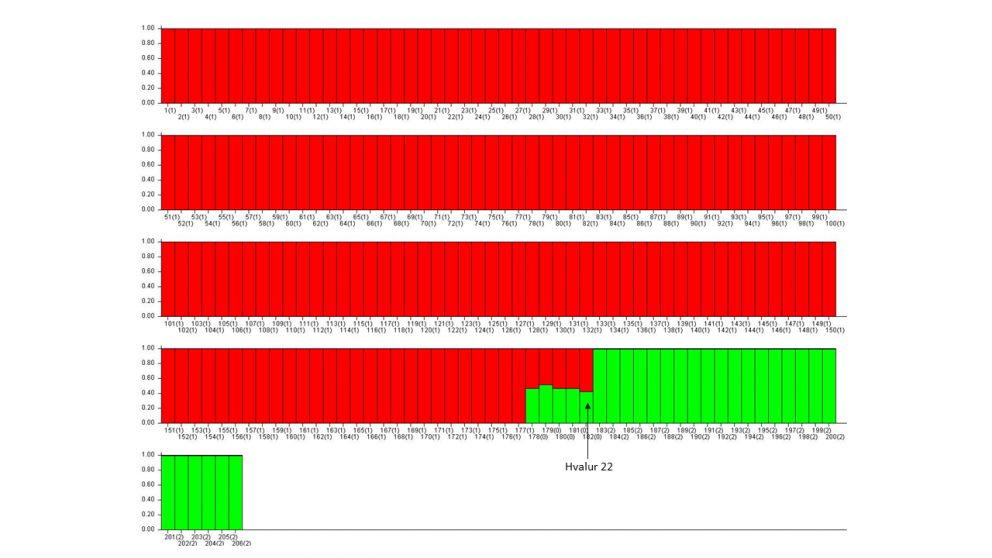- Research
- Fish tagging
- Lumpfish research
- Oceanography
- Seabed mapping
- Arnarfjörður
- Drekasvæði
- Ísafjarðardjúp
- Jökulbanki
- Jökuldjúp
- Kolbeinseyjarhryggur and adjacent area
- Kolluáll
- Langanesgrunn
- Látragrunn
- Nesdjúp
- Reykjaneshryggur and adjacent area
- Selvogsbanki
- South of Selvogsbanki
- South of Skeiðarárdjúp
- South of Skerjadjúp
- Southeast of Lónsdjúp
- Southwest of Jökuldjúp
- Suðausturmið
- Suðurdjúp
- Vesturdjúp
- East of Reykjaneshryggur
- Vestfjardarmid
- Seal research
- Whale Research
- Advice
- About
Press release from the Marine and Freshwater Research Institute (MFRI) - Peculiar baleen whale – genetic results
19. July 2018
 The figure shows the results of that analysis using the analytical tool STRUCTURE. The figure shows the results for all 206 whales analysed.
The figure shows the results of that analysis using the analytical tool STRUCTURE. The figure shows the results for all 206 whales analysed.
On July 7th a whale was landed at the Hvalfjörður whaling station in Iceland that had morphological characteristics of both fin and blue whales. A staff member of the MFRI conducting biological sampling at the station reported the incident and did appropriate arrangements for sampling and measurements.
A preliminary conclusion of the MFRI was that the animal was a hybrid and a genetic confirmation would be investigated at the end of the season as has been the practise on previous occasions when alleged hybrids have been caught. In the wake of intense public debate that this whale was possibly a pure blue whale it was decided to conduct the genetic analysis as soon as possible to seek a final confirmation on the identity of the whale. This analysis has now been completed.
The genetic results confirm the preliminary assessment that the whale in question that was caught on July 7th was a hybrid of a fin whale father and a blue whale mother.
More about the research
The genetic analysis was conducted at the laboratory of MATÍS and the resulting data was analysed by the MFRI‘s genetic specialist in collaboration with geneticists from MATÍS. The sample in question was analysed together with samples from other fin/blue whale hybrids collected from the hunt since 1983, a total of 5 individuals. In addition, analysis was conducted on the 24 fin whales already sampled this year and 154 fin whales from the 2015 season. We also analysed older samples from blue whales (23 individuals) from the tissue collection of the MFRI.
Two methods were applied for the analyses, sequencing of mitochondrial DNA (mtDNA) and analysis of 15 microsatellite loci of nuclear DNA (nDNA).
The mitochondrial DNA is inherited directly from the mother and the analysis confirmed that the mother of whale No 22 was a blue whale. As the mitochondrial method does not inform the identity of the father a further analysis was conducted with the microsatellite method mentioned before.
The attached figure shows the results of that analysis using the analytical tool STRUCTURE. The figure shows the results for all 206 whales analysed. The uniform red coloured bars show fin whales and the uniform green bars show blue whales. The five samples that are both red and green are from whales identified as hybrids. Some of these have previously been confirmed as hybrids and the results published in peer reviewed journals. The whale in question caught on the 7th July is labelled as Hvalur 22 on the figure. The results confirm that all the whales identified as hybrids are 1st generation hybrids where one of the parents is fin whale and the other parent a blue whale.
As mentioned above, the results of the genetic results confirm the preliminary assessment that the whale in question that was caught on July 7th was a hybrid of a fin whale father and a blue whale mother.
Marine and Freshwater Research Institute, 19. July 2018.
